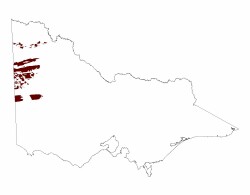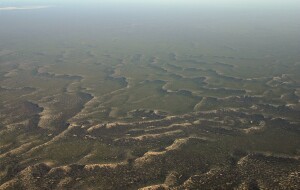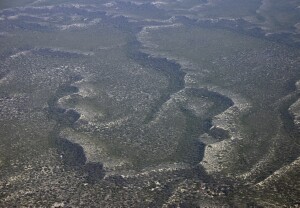5.2.1 Parabolic dunes and sandplains (dominant in west and central Big Desert)
5. North Western Dunefields and Plains (DP)
5.2 Siliceous dunefields (Sunset, Big and Little Desert)
| Sub-parabolic dunes are particularly widespread in the Big Desert, frequently enclosing broad sand plains. The largest individual areas of parabolic dunefields cross the Big Desert in three east-west swathes to the west of the valley containing the Wimmera River. The swathes are some 10-20 km wide and up to 90 km long. They cross the broad ridge running south-east from the Pinnaroo Block, as well as stranded ridges and associated swales. In the Sunset Desert a swathe crosses the regional depression to the east of the Millewa Ridge. Orientation of the dunes is variable, but mostly south west – north east. Large sub-parabolic forms may be some 30 m high and 4 km long, commonly with sharps crests, with arms opening towards the south west and with slip faces to the south and east. Dune alignment tends to be irregular rather than straight or smoothly – curved, and there may be small, barchan-like segments. The parabolic dunes often enclose large plains 1 km or more across. These plains may contain small sub-round to linear dunes of variable orientation. The small dunes are mostly smooth-crested. |  |
The soils are “Rudosols”, lacking development other than accumulation of a little humus at the surface. Below the humus there are deep, loose, yellow sands over the whole landscape. In profiles examined to the south of Murrayville, coarse sand predominated and carbonates were confined to occasional flecks, presumably derived from dust deposited during arid periods. The reaction is neutral in the top metre or so, but alkaline below this. Values for all plant nutrient examined were low – exchangeable metal cations, nitrogen and potassium. Lowan Sand is also known to be deficient in trace elements such as copper and zinc.
Vegetation across the three deserts varies with the large shift in climate. Average annual rainfall declines from 500 mm in the Little Desert to less than 300 mm in the Sunset Desert, and temperatures increase in the same direction. In the Big and Little Deserts heathlands predominate, with an abundance of species from genera such as Banksia, Xanthorrhoea and Epacris. These species sometimes form an understorey to mallee eucalypts, particularly along sheltered slip faces, the stands being known as “mallee-heath”. In the Sunset Desert, aridity is too great for heath which is replaced by mallee scrub with a prominent understorey of Tea-tree.
 |  |


